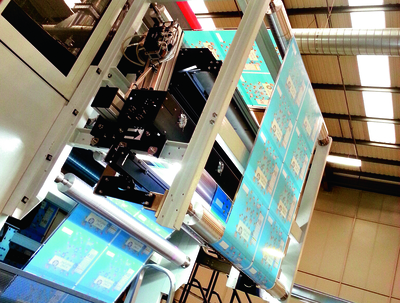AVT’s PrintVision/Argus installed on a flexotecnica press
The end user of printed packaging today demands high quality and there is little room for print faults. Web inspection systems help ensure that these are eliminated. By Neel Madsen.
In today’s closely fought print market, high quality, consistent and faultless print is expected by customers. Inspection technology has evolved significantly and encompasses more than simple print fault detection. Sophisticated systems can also manage colour to ensure that brand colours are matched.
Colour and quality
QuadTech’s systems for flexo and gravure packaging applications include inline inspection and spectral colour measurement solutions for films, foils, papers and laminates, designed to reduce makeready times, accelerate throughput, provide quality assurance, ensure customer satisfaction and increased competitiveness.
Karl Fritchen, president, said, ‘Brand owners are becoming more and more demanding when it comes to colour quality and controlling costs. Our automated solutions are designed to meet those demands, and to streamline operations.’
The company offers the Color Quality Solution, which combines inline spectral colour measurement, ink formulation data and ink dispensing technology to ensure accurate colour matching. Colour targets are loaded into the Color Measurement System with SpectralCam, which collects and maintains live spectral data inline, at full press speeds. Deviations are captured and the spectral data sent back to the X-Rite Ink Formulation software via a CxF file. This automatic measurement and reformulation maintains color quality while reducing waste and downtime.
For print quality consistency, the company has the QuadTech Inspection System, which constantly checks 100% of the web. This can be used with opaque, translucent and transparent substrates as well as on reflective materials, and detects process faults including streaks, hazing, colour variation and mis-register, as well as random defects such as spots, mis-prints and hickies.
The Web Viewing System can be used as a standalone system, or in conjunction with the Inspection System, for real-time viewing of the moving web and optimum defect viewing. High magnification with high image clarity enables operators to identify faults before they are visible to the human eye, so remedial action can be taken before defective copy is run.
QuadTech’s PDF Verification software is an option that enables printers to catch errors before they go into production, by comparing approved artwork to a printed sample, ensuring correct press set up, print accuracy and quality.
Other solutions include DataCentral for Inspection, a database that stores job and defect information from one or more presses and facilitates quality control decisions; while the Waste Management System takes quality control information from QuadTech DataCentral, and enables automatic control of the slitter/rewinder/sheeter to ensure that defective material is removed efficiently.
Going turbo
Following its rebrand, AVT has introduced an enhanced set of inspection and quality control solutions. The company’s Turbo series, which include Apollo Turbo, Argus Turbo and Argus E Turbo provides a number of features, including high resolution inspection, workflow support and job verification tailored to the needs of packaging production lines.
Named for its fast and accurate vision system, the Turbo series is supported by a new dedicated LED illumination technology with the camera providing what the company describes as ‘an unprecedented combination of high resolution, high volume quality control.’ JobRef has been modified to specifically address the needs of the packaging sector. It enables verification at the set up stage by automatically comparing the current job to the original PDF file.
Other new modules include PrintFlow II, with enhanced data collection and reporting abilities. Introducing a new user interface designed for touch screen monitors, new look and feel, new features and improved statistical tools and visual aids, the module boosts reporting and quality assurance abilities. PrintFlow Central serves as central storage for the PrintFlow database; while Quick set offers fast, ‘zero set up’ for repeating jobs.






